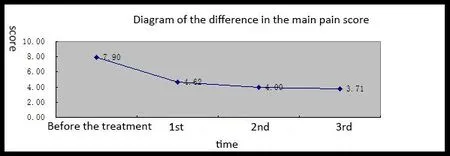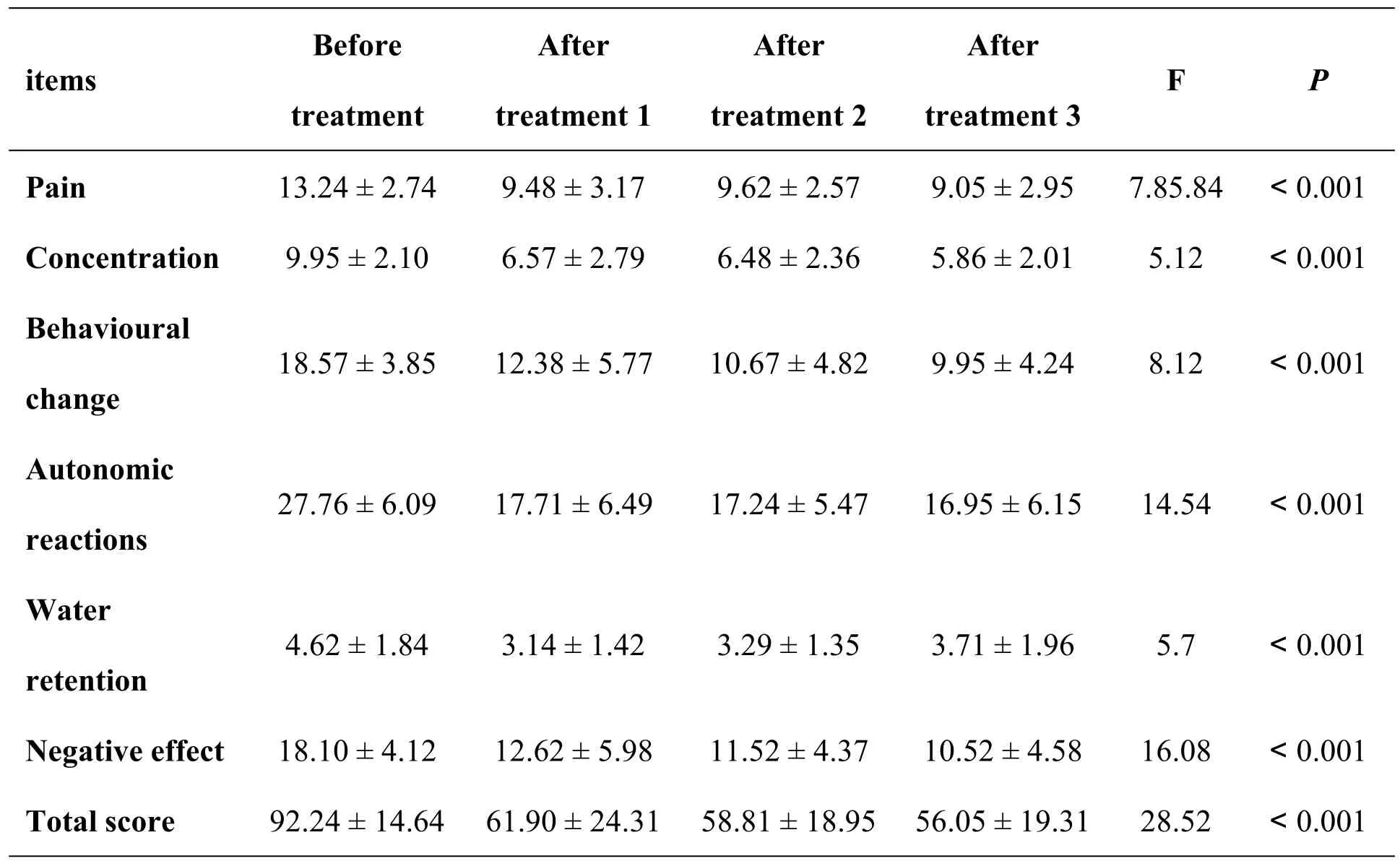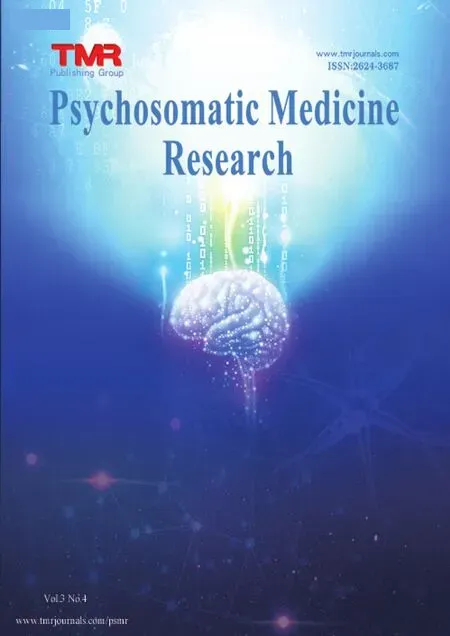Intervention Study on Hypnotherapy of Primary Dysmenorrhea in Female College Students
Yu Wang,Ting Wang*
1Nanjing University of Chinese Medicine,Nanjing,Jiangsu province 210046,China.
Abstract
Objective:To understand the relevant situation of primary dysmenorrhea among the subjects and target the relief of pain and associated symptoms through hypnotherapy only.
Methods:The study recruited a total of 23 female college students who underwent primary dysmenorrhea as objects and conducted a self-report study.The clinical effect of hypnotic suggestion on primary dysmenorrhea was analyzed using the Visual Analogue Scale and the Menstrual Distress Questionnaire as observation indexes.
Results:This finding demonstrated a significant reduction in the primary pain score after treatment(t=6.59,P<0.01).Moreover,no significant difference was noted between the first time and the second and third times after treatment.A significant difference was observed in the total scores of MDQ before and after treatment,which indicated the positive effect of hypnotherapy(F=28.52,P<0.001).After treatment,the scores of pain(F=7.85,P<0.001),concentration(F=5.12,P<0.001),behavioural change(F=8.12,P<0.001),autonomic reactions(F=14.54,P<0.001),water retention(F=5.7,P<0.001)and negative effect(F=16.08,P<0.001)were significantly lower than that of before treatment.Through a comparison of the correlation between the reduction rate of pain score and suggestibility at different stages of treatment,the study noted no significant correlation(P>0.05).
Conclusion:The experimental results demonstrate that hypnotherapy is effective in treating primary dysmenorrhea.hypnotherapy intervention can improve negative emotions and level of attention and promote behavior change.
Keywords:Hypnotherapy,Primary dysmenorrhea,Female college students
Background
Dysmenorrhea is classified into two types:primary and secondary.The former is known as functional dysmenorrhea,which is caused by non-pelvic organic lesions.It primarily occurs in young women with ages ranging 15–25 years and 1–2 years after menstruation [1].The latter refers to several pathological organic alterations in the genital tract,which is mainly observed in women of childbearing age.For female college students, primary dysmenorrhea leads to low efficiency in class and influences social life,which is seriously detrimental to physical and mental health[2,3].
According to an epidemiological survey conducted by Meng WL et al[4],primary dysmenorrhea is the most common disease in gynecology,where 20%–90% of women experience different degrees of primary dysmenorrhea.Lately,this rate has been increasing owing to lifestyle changes and eating habits.These days,western medicine is mainly used to treat primary dysmenorrhea, such as oral contraceptives,prostaglandin synthase inhibitors,and other treatments.Alternatively,traditional Chinese medicine(TCM)primarily uses Chinese medicinal herb,psychological intervention,and acupuncture[5-8].These methods effectively reduce the degree of pain associated with primary dysmenorrhea.
Hypnotherapy is one of the psychological interventions.Hypnotherapy is a time-honored technique whose early use has been associated with pain.In 1955,the British Medical Association officially recommended the use of hypnotherapy in the medical field.Its definition,that is,the use of special behavioral techniques combined with verbal cues to induce a normal person into a temporary sleep-like state,remains widely accepted today.In the hypnotic state,a patient may obey the suggestions of a healer to treat certain diseases.Moreover,hypnotherapy is widely used for pain management with considerable benefits.It can empower and encourage the patient to adopt a healthy and proactive approach to pain management.Currently,hypnotherapy is successfully used to treat various pain problems,such as tooth extraction,headache,and childbirth pain among others[9-11].Previous studies demonstrate that menstrual pain is linked to the brain's pain network[12].Thus,hypnotherapy helps a patient enter a state of trance and create a new network in which they can feel safe,comfortable,and warm.
This study aims to investigate the effect of pain intervention in college students using hypnotherapy to suggest effective methods of relief and coping strategies for female college students suffering from menstrual pain.Furthermore,this study is conducted from the perspective of own factors to promote physical and mental health of female college students and improve quality of life and learning efficiency during menstrual cycles.
Methods
Participants
The study recruited a total of 23 female college students from the Nanjing University of Chinese Medicine and Nanjing Normal University,who were screened after an online announcement.Two participants were excluded for taking drugs during the treatment.Therefore,data from only the remaining 21 participants were used for analysis.
The inclusion criteria include students(1)aged between 18 and 22 years,(2)who meet the diagnostic criteria for primary dysmenorrhea,(3)whose course of disease is more than one year,(4)with visual analogue scale(VAS)score greater than or equal to 4,and(5)with signed informed consent.
Consequently,the exclusion criteria are students(1)who received drug therapy or other non-drug therapy in the past three months,(2)with serious complications,and(3)who have a serious mental disorder.
Design method
This experiment employed a self-controlled design.Data were collected by a non-dominant participant in the experiment.Each participant used the primary data to compare using the indirect reporting method.Following the treatment,follow-up was conducted to collect data for a period of three months.The study examined the effect of hypnotherapy by comparing the VAS score and concomitant symptoms of the subjects in the period before and after the treatment.The effect of the natural course of the disease was excluded by collecting data at a fixed time,such as the first day of the menstrual cycle.
The specific contents are as follows.(1)Interview:Before the treatment,the subjects were interviewed to comprehend their basic information,such as age of menarche,description of their unique menstrual cycles,duration of menstruation,period of pain,and duration of pain.In addition,the imaginary pains of the participants were identified and described using specific shapes,colors,and changes to obtain images for hypnotherapy,which were later considered elements of hypnotherapy.Through the self-energy of the participants,the interview process revealed that many interviewees used numerous measures to treat dysmenorrhea,such as hot packs,brown sugar water,and wormwood patches,which provided further insights about their attitudes toward menstruation and dysmenorrhea.(2) Treatment: The participants assessed the degree of pain using the VAS scale before the treatment by gauging whether the pain affected their daily study or life.No pain is denoted by 1,whereas the most severe pain is denoted by 10.Concurrently,they were requested to fill up the Menstrual Distress Questionnaire(MDQ)prior to the treatment.
In total,the study employed two measurements,which were designed on the basis of their last menstrual period.The first treatment was conducted within the 14-20 days after the last day of menstruation,whereas the second was conducted 3-7 days before the next menstruation cycle.Hypnotic content included standard instructions,the imagery of a warm stream running inside the uterus with their own energy under the guidance of self-suggestion,and the last wake-up call.During the treatment,the description of the participants of warm feeling was selected as the hypnotic imagery.If the participants could be the creator and obtainer of the energy,then it would be beneficial to hypnotherapy with twice the results.Some participants received group hypnotherapy during the second treatment,which verified that group hypnotherapy could lead to positive results owing to sharing and increased interaction with one another.Barring the two treatments performed by hypnotists,the participants could also practice every day during treatment intervals to feel and familiarize themselves with the treatment process.Moreover,the participants were allowed to adjust practice frequency based on individual results to enhance the therapeutic effects.
Observation indicators
VAS.The VAS was used to evaluate dysmenorrhea and pain before and after intervention.A horizontal line of 10 cm was drawn on a paper.One end of the horizontal line was marked as 0(painless),whereas the other end was marked as 10(severe pain).The middle part of the line represented different degrees of pain.The subjects marked their level of pain on the horizontal line.The higher the score,the more intense the dysmenorrhea.
MDQ.The MDQ was used to evaluate symptoms associated with menstruation.The MDQ was considered an effective tool for assessing the physical and psychological symptoms of menstruation and was deemed suitable for the screening of premenstrual syndrome symptoms among women of different sizes and reproductive ages.Moos RH[13]developed the original scale in 1968,which was revised by Park HY[14]in 1988.Currently,it is the most commonly used assessment tool for menstrual symptoms in other countries.The scale comprises 30 items,out of which five pertain to pain related symptoms,three for attention loss,five for behavior change,nine for the reaction of the autonomic nervous system,two for water and sodium retention,and six for negative emotions.Items were rated using a 5-point Likert-type scale ranging from 1 to 5.(1= “none at all”, 2=“almost none”,Socre 3= “often”,4= “relatively serious”,5= “very serious”)The total scores range 30-150 points.The higher the total score,the more severe the symptoms[15].
Hypnotic suggestive assessment.This study refers to the study of Zhan QS,et al.[16],which uses the suggestibility test with eight items.The evaluation standard is similar:judgment or no change is denoted by 0;a difference in judgment is denoted by 2;and refusal is denoted by 1.The higher the score,the stronger the suggestibility.
Statistical methods
SPSS 19.0 statistical software was used to analyze the data.Repeated measures analysis of variance,paired sample t-test,and correlation analysis were used for intra-group comparison.
Results
Comparison of scores for subjective pain before and after treatment
Figure 1 presents the comparison of the scores for subjective pain once before the treatment and three times after the treatment.A significant difference was observed in the main pain score(t=6.59,P<0.01)before and after treatment.This finding demonstrated a significant reduction in the primary pain score after treatment.Moreover,no significant difference was noted between the first time and the second and third times after treatment.

Figure 1 Comparison of pain scores from one time before treatment to three times after treatment
Comparison of MDQ scores before and after treatment
Table 1 depicts the results of the comparison of scores of the MDQ before and after treatment.After treatment,there are significant differences in items pain(F=7.85,P<0.001),concentration(F=5.12,P<0.001),behavioural change(F=8.12,P<0.001),autonomic reactions(F=14.54,P<0.001),water retention(F=5.7,P<0.001),negative effect(F=16.08,P<0.001).The scores for these six items were lower than that of before treatment.A significant difference was observed in the total scores before and after treatment,which indicated the positive effect of hypnotherapy(F=28.52,P<0.001).

Table 1 Comparison of MDQ scores after treatment
Comparison of suggestibility and therapeutic effect
The participants were subjected to a suggestive assessment before treatment.This process comprises five levels of assessment ranging from 1 to 5.Through a comparison of the correlation between the reduction rate of pain score and suggestibility at different stages of treatment,the study noted no significant correlation(P>0.05).Therefore,the study inferred that no significant correlation exists between the suggestibility of the subjects and the therapeutic effect.
Discussion
Occurrence of primary dysmenorrhea
With the popularization of health care knowledge,many women possess certain levels of understanding of menstrual onset,whereas the majority can effectively address dysmenorrhea.Nevertheless,the rate of primary dysmenorrhea is high.Notably,many participants or their mothers fail to attach sufficient importance to menarche onset barring its physiological and pathogenic factors.The first dysmenorrhea tends to occur six months after menarche accompanied by corresponding social life events.Therefore,whether the occurrence of primary dysmenorrhea is related to attention from female themselves or their connections,especially from very close ones,warrants further exploration.
Modern clinical hypnotherapy with“stagnation leading to pain”as the pathogenesis of treatment
The pathogenesis of dysmenorrhea is diverse[17].Chinese and western medicine have conducted many studies on this topic.TCM believes that primary dysmenorrhea is primarily owing to the influence of pathogenic factors on women during the menstrual cycle,which leads to the Chong Ren Yu block or cold coagulation meridians.Alternatively,the Qi and blood operation are not in sync,whereas the cell palace meridian blood circulation is blocked.According to the time and nature of pain,the characteristics of menstruation,and the patient's constitution,the treatment for dysmenorrhea can be classified based on symptom differentiation as follows:Qi stagnation and blood stasis;cold dampness stagnation;dampness and heat stasis;Qi and blood weakness;and liver and kidney deficit syndromes[18].Pain owing to Qi stagnation and blood stasis and cold dampness stagnation is related to western medicine.Stasis and cold suggest a certain mechanism;thus,the main treatments are passing,melting,and thinning.For example,participants were instructed to imagine warm water moving to the uterus to heat the uterus,which slowly melts the congestion in the uterus and removes waste products,such as congestion,until the uterus regains its normal size and temperature.This“through-and-change” operation is simple: after understanding the treatment process,the subjects can fully with the assistance of the recording of the imagination and treatment and without the involvement of a hypnotist.
Hypnotherapy takes “stagnation leading to pain”as its mechanism.In the course of the treatment,the subjects used the hypnotic images of the warm experience.The study employed modern hypnotherapy,which emphasized the resources and energy of the subjects themselves.For instance,in the instruction,the subjects were asked to imagine a warm feeling flowing to heat the uterus,slowly melt the congestion,and gradually eliminate the congestion and other wastes until the uterus regains its normal size and temperature.The operation of communication and conversion was simple.After understanding the treatment process,the subjects could imagine and treat themselves with the help of the recording without the involvement of a hypnotist.However,this treatment is intended for subjects with dysmenorrhea owing to qi stagnation and blood stasis.For those with dysmenorrhea owing to qi stagnation and blood stasis,the treatment method should be more cautious,whereas the hypnotic image should be adjusted.
Evaluation of the effect of modern clinical hypnotherapy on dysmenorrhea
The suggestibility of the participants was assessed prior to treatment.Generally, the higher the suggestibility score,the deeper the hypnotherapy.However,no significant correlation was found between suggestibility and therapeutic effect.The reason for this difference from the traditional conclusion may be related to the practice times and the unique characteristics of the participants.We believe that the more they practice,the better they gain skills for application;thus,the more evident the result.
The effects of the self-controlled trial of hypnotherapy were evaluated by identifying differences in subjective pain scores at various time points.The self-controlled method is meaningful for changes of quantitative scores are objective and comparable,although sensitivity to pain differs among individuals.Therefore,comparing quantitative scores is logical.The effect of hypnotherapy,that is,pain reduction,may be due to the increase of the pain threshold and the decrease of susceptibility to pain owing to attentional focus when people undergo moderate or extreme hypnotherapy.This notion is supported by evidence from neurobiological imaging.
According to the score of the concomitant symptoms of menstruation,After treatment,there are significant differences in items pain(F=7.85,P<0.001),concentration(F=5.12,P<0.001),behavioural change(F=8.12,P<0.001),autonomic reactions(F=14.54,P<0.001),water retention(F=5.7,P<0.001),negative effect(F=16.08,P<0.001).The scores for these six items were lower than that of before treatment.The results indicate that hypnotherapy intervention can improve negative emotions and level of attention and promote behavior change.Therefore,hypnotherapy can not only arouse the attention of resources used to actively build a sense of safe and comfortable feeling that induces calm and thus reduces the levels of anxiety but also promote behavior change and mental relaxation and reduce pain sensitivity.A significant difference was observed in the total score before and after treatment,which pints to the positive effect of hypnotherapy[19].
Research innovation and limitations
Hypnotherapy is widely used in the field of pain management.However,relevant studies that report the application of hypnotherapy in the intervention for the dysmenorrhea of college students in China are scarce.Currently, the empirical results of hypnotic intervention in the comprehensive literature are relatively lacking.The current study used the Erikson clinical hypnotic method to provide intervention for dysmenorrhea with remarkable results.To examine the therapeutic effects,the study used scoring indexes that are subjective and lack objectivity.Further studies should observe changes in serum estrogen E2,progesterone P,β-endorphin,and other physiological indicators before and after treatment to elucidate the experimental effect.
Conclusion
The experimental results demonstrate that hypnotherapy is effective in treating primary dysmenorrhea.The method of hypnosis in the treatment of primary dysmenorrhea is feasible and the further exploration and application is worthy.
 Psychosomatic Medicine Resesrch2021年4期
Psychosomatic Medicine Resesrch2021年4期
- Psychosomatic Medicine Resesrch的其它文章
- Advances in the Pathogenesis of Vascular Cognitive Impairment
- A Commentary of the Queer People of Color Identity Affirmation Scale for Positive Attitudes
- Left Temporal Lobe Arachnoid Cyst Presenting with Symptoms of Psychosis
- An Assessment of the Relationship Between Mizaj and Happiness in College Students During and After Complete Lockdown
- Analysis of the Influence of the Self-efficacy of College Students on Their Response Behaviors Toward COVID-19
